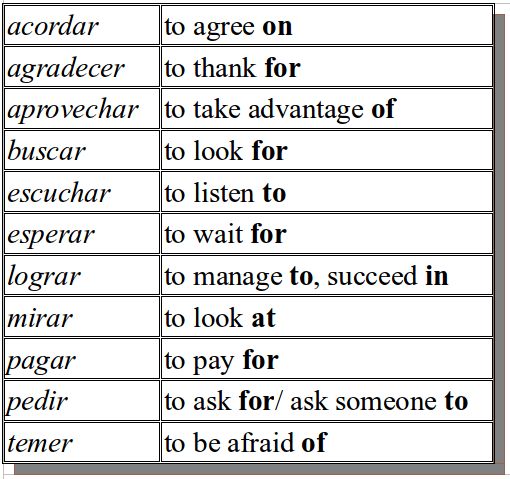You are here
5.2 Translating Prepositions
To conclude this lesson, we’ll explore the translation of prepositions from Spanish to English. Prepositions are those little words that help show a relation between various parts of a sentence, and can be used with nouns or verbs. Common prepositions in Spanish are “a, de, en, con, por, para, encima de, debajo de..”etc., and in English, “to, from, in, on, with, for, by, around, through, above, below..”etc. Here we won’t focus on prepositions regarding location as these usually have a straightforward meaning in both languages, but rather on the use of prepositions with certain verbs in English and Spanish that aren’t matched in the other language, as well as ways to translate por and para.
a) Verbs that take prepositions in Spanish but not English
There are some verbs that are always used with prepositions in Spanish, but not in English. We do not translate the preposition in this case, but rather translate the phrase into English in a natural way. For example:
Example 5.5
Ayudar a - to help
Tratar de - to try
Casarse con - to marry
Acabar de - to have just
Dejar de - to stop
b) Verbs which lack a preposition in Spanish but require one in English
There is another set of verbs which do not have a preposition in Spanish, but do require one in English. These are listed in the following figure:
Figure 5.3

Example 5.6
For verbs in Spanish that do not take a preposition when the equivalent in English does, be sure to include the preposition in the translation.
Source Text
Translation
c) Translating por and para
The prepositions por and para in Spanish both have many uses and possible translations to English. Let’s look at some of the most common usages and translations for each.
- The Spanish preposition para most often means “for” in English.
To indicate who or what something is for
To indicate destination
To make comparisons
To express “in order to”
- The preposition por has many more usages and can be translated to a variety of words in English.
To describe approximate location
To communicate means of transportation
To communicate means of communication
Meaning per
Meaning “however” or “no matter”
To express personal opinion/ convenience
Meaning around or approximately
To express something about to happen
To indicate location, and motion
Meaning for to express duration of time
When translating prepositions, it is especially important to remember our maxim that message has priority over form. Since prepositions can have a wide variety of meanings, it is important to find a way to translate the phrase in which they are used that sounds natural in the target language.
